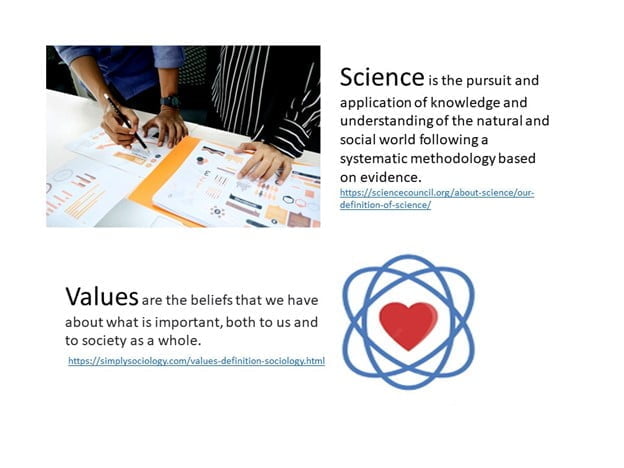Two Narratives About Values and Population Health Science — and a Blog Series to Explore Them
Christine BachrachHow do our values affect our science — what we study, how we frame our questions, how we conduct our research, and how we report and translate it? The intertwining of values and science is always worth thinking about, but as population health scientists, now is an especially important time to have that conversation.
Today, most of us inhabit a world that is ideologically and politically polarized, and polarized around many of the issues we study — racial justice, immigration, inequality, public health policy, and more. Political debates about systemic racism, gun control, abortion, and gender identity have become flashpoints of public discourse, with implications for individual health choices and policies impacting population health. These discussions have called into question how science is done and who has the authority to dispense knowledge. How should population health, a field largely populated by individuals with liberal or progressive views, most effectively pursue its work in this context? How are our values influencing our work and what are the implications for our science?
Within IAPHS, answers to these questions vary a lot. Two narratives draw out some of the key contrasts between our views:
Narrative 1:
People with progressive values are naturally drawn to population health science because the upstream focus of the field inherently aligns with liberal values and prescriptions. These values do and should motivate our science. In fact, science can be a valuable asset for advancing progressive values because it can make the case for progressive policies. We don’t need to engage people with conservative values in our scientific discussions – their ideas are readily accessible. Of course, scientists should never let their values get in the way of producing rigorous, honest research – that would be wrong. We should just be honest about who we are and shouldn’t feel shy about advocating for what we believe in.
Narrative 2:
The overwhelming tendency of population health scientists to lean left on the political spectrum is a liability. Scientists’ personal values rightly influence what they choose to study, but values can also create blinders that limit the kinds of questions asked, how those questions are framed, and the consideration of appropriate policy responses. Conservative thinkers do have relevant perspectives about population health and offer prescriptions that differ from those that most liberals favor. Unless we can draw these ideas into the mix of our discussion and debate, we create an echo chamber that limits the scope of our research, constricts our science, and worse still, works to silence the voices of individuals who have dissenting views within our community.
The Blog Series
This Blog series on “Values and Science” will explore and interrogate both narratives and the differences between them. The goal is to stimulate a wide-open and hopefully provocative discussion that raises awareness of how we differ and how we can accommodate our differences. We also hope to explore the implications for IAPHS as a “big-tent” scientific organization.
We’ll start by delving into a proposition that we all agree on — values and science are intertwined. In the next post, we’ll hear from an intentionally diverse group of IAPHS members about how values affect their work and how they balance their personal beliefs with their commitments to research integrity. Subsequent posts will examine how values can affect science and the elusive concept of objectivity in science. Next, we’ll look at political and ideological polarization in the US and where population health scientists tend to fall on the political spectrum: what are the implications for the credibility of our science across different audiences? We’ll revisit our interviewees in the next post to hear their opinions on whether and how the dominance of liberal values in population health might matter for the health of our field.
You can express your views on the issues at a town-hall style session at the IAPHS Conference in Baltimore. Mark your calendars for October 2-5, 2023, and plan to attend! We’ll post some questions to consider before the conference. After the meeting, we’ll develop a final post which will reflect on lessons learned.
What do we mean by “values?”
We define values as “beliefs we hold about what is important to us and the world.” Think of values as a mental model of how the world should be, a model that includes beliefs, concepts, and treasured end-states. This concept of values is closely related to the definition of “worldview”— a “collection of attitudes, values, stories and expectations about the world around us, which inform our every thought and action.” Our values are rooted in our location in society and the conditions of our lives. They take shape and evolve through interactions with family, friends, and communities and exposure to media content.
The values most relevant to this series are the beliefs and positions we hold about “politically fraught” issues; that is, issues that are aligned with the deep divisions between liberals and conservatives in our country. Some examples might include environmental regulations, income inequality, racial justice, the rights of a fetus, and government safety-nets. We recognize that the divisions in our country are not as sharply defined as they sometimes appear in the media and political debate. We recognize that it is simplistic to try to put people into boxes with these labels — most of us hold at least some beliefs and positions that can’t be neatly pigeonholed, even if we could agree on what the labels mean. We use the labels as a shorthand device to refer to the real and salient differences across populations in our country that have ignited cultural and political battles — battles raging around topics relevant to our science. 
Join the conversation!
We’re undertaking this blog series because the entanglements of values and science, and their implications for population health science in a polarized world, can be uncomfortable to question and difficult to discuss. We believe that putting our views on the table for respectful and empathic discussion can be good for science and good for IAPHS. We have an opportunity to learn from each other, and, perhaps, to spark new insights and innovations in what is already a robust area of science.
Please join the conversation! Your insights and opinions are the key to building a rich and productive discussion. In order to post a comment, you need to log in to the IAPHS website here. Then scroll down below this post to find the comment box. You are also welcome to enrich the conversation by crafting a post of your own — just contact Jarron Saint Onge, IAPHS Blog Editor, at jarron.saintonge@ku.edu.
About the authors
Christine Bachrach is Senior Advisor to IAPHS and the organizer of this Blog series. She accepts full responsibility for its content as a representation of the authors’ thoughts and opinions, and not necessarily the opinion of IAPHS as an organization. Many individuals, listed below, have also volunteered to contribute their ideas and suggestions. Special thanks are owed to the following people who provided substantive suggestions on this blog post: Caryn Bell, Erika Blacksher, Kaori Fujishiro, Taylor Hargrove, Jennifer Karas Montez, Sanne Magnan, Kat Theall, and Anna Zajacova.
Project advisors: Yukiko Asada, Caryn Bell, Erika Blacksher, Marino Bruce, Merlin Chowkwanyun, Cynthia Colen, Jen Cruz, Jenn Dowd, Kaori Fujishiro, Taylor Hargrove, Kathie Harris, Mark Hayward, Jennifer Karas Montez, Nicholas King, Lindsey Leininger, Sanne Magnan, Jarron Saint Onge, Kat Theall, Alex Tsai, and Anna Zajacova.





All comments will be reviewed and posted if substantive and of general interest to IAPHS readers.